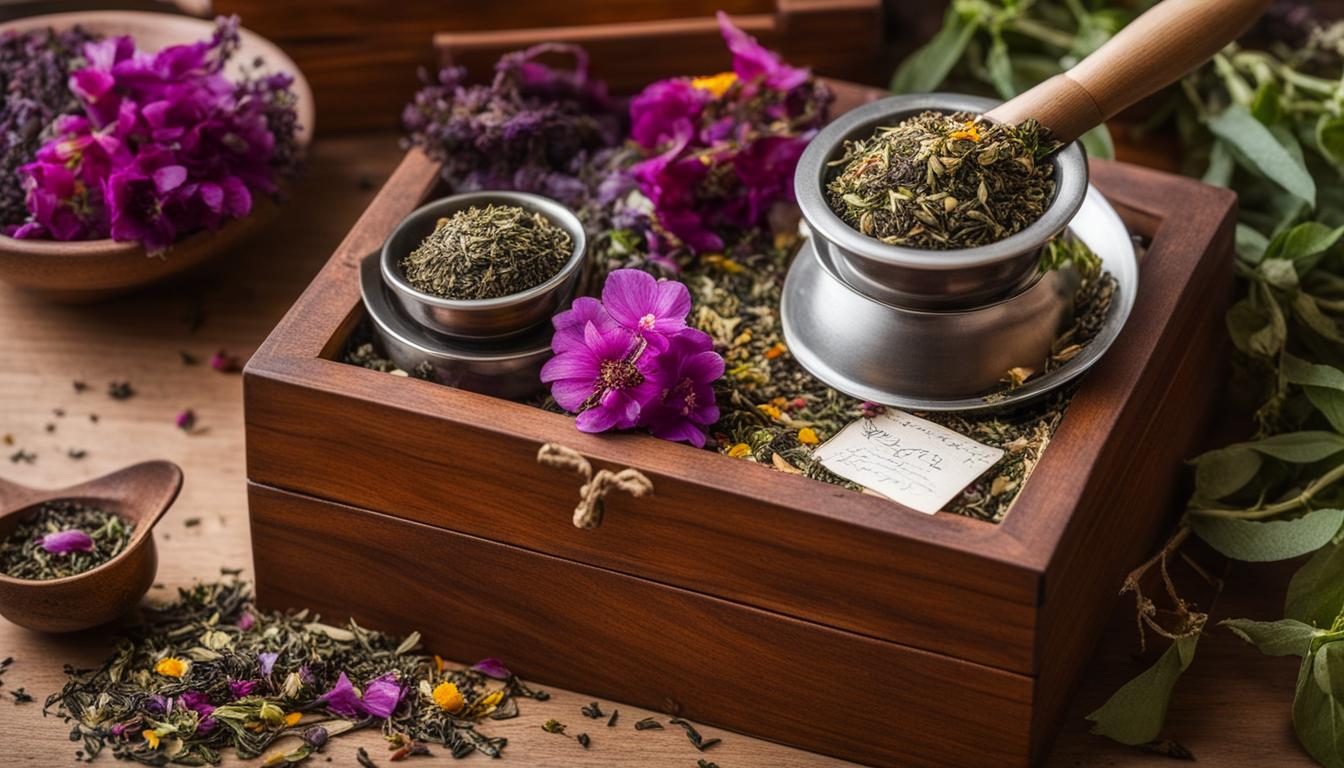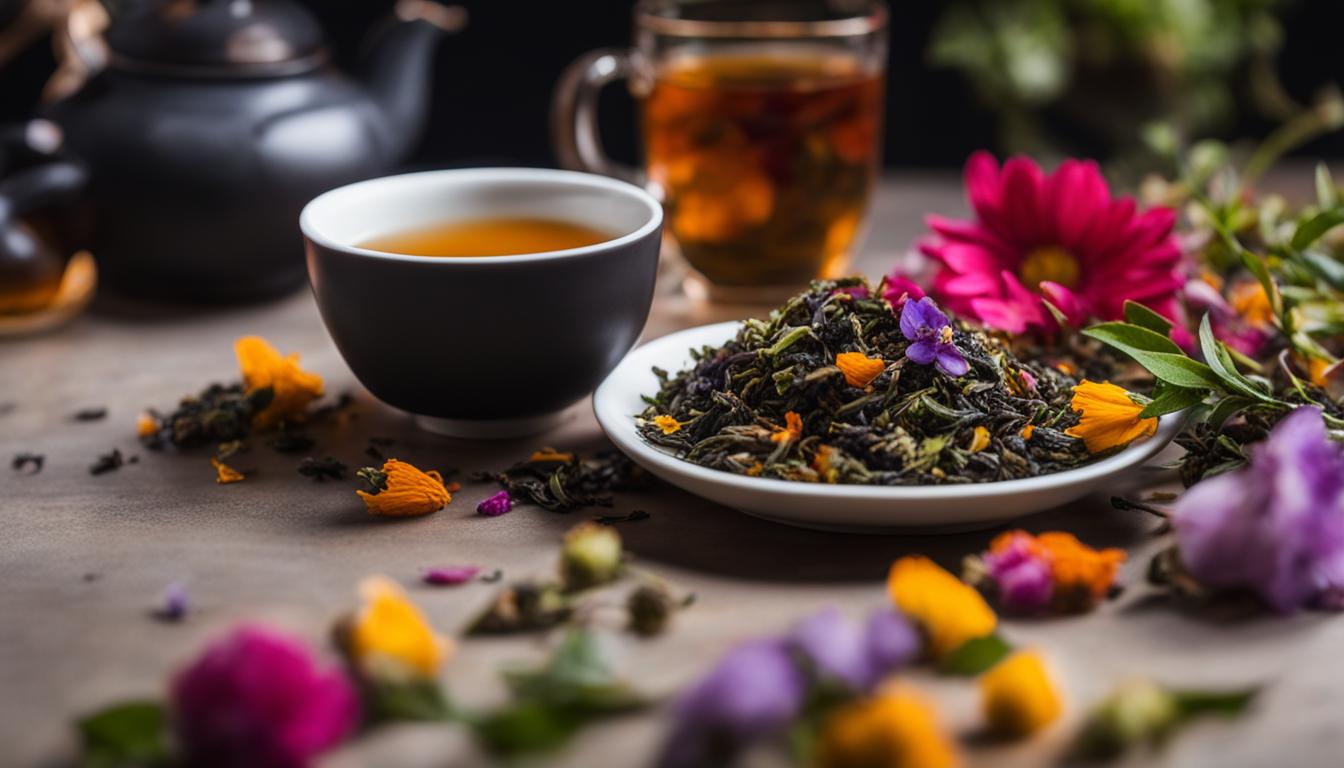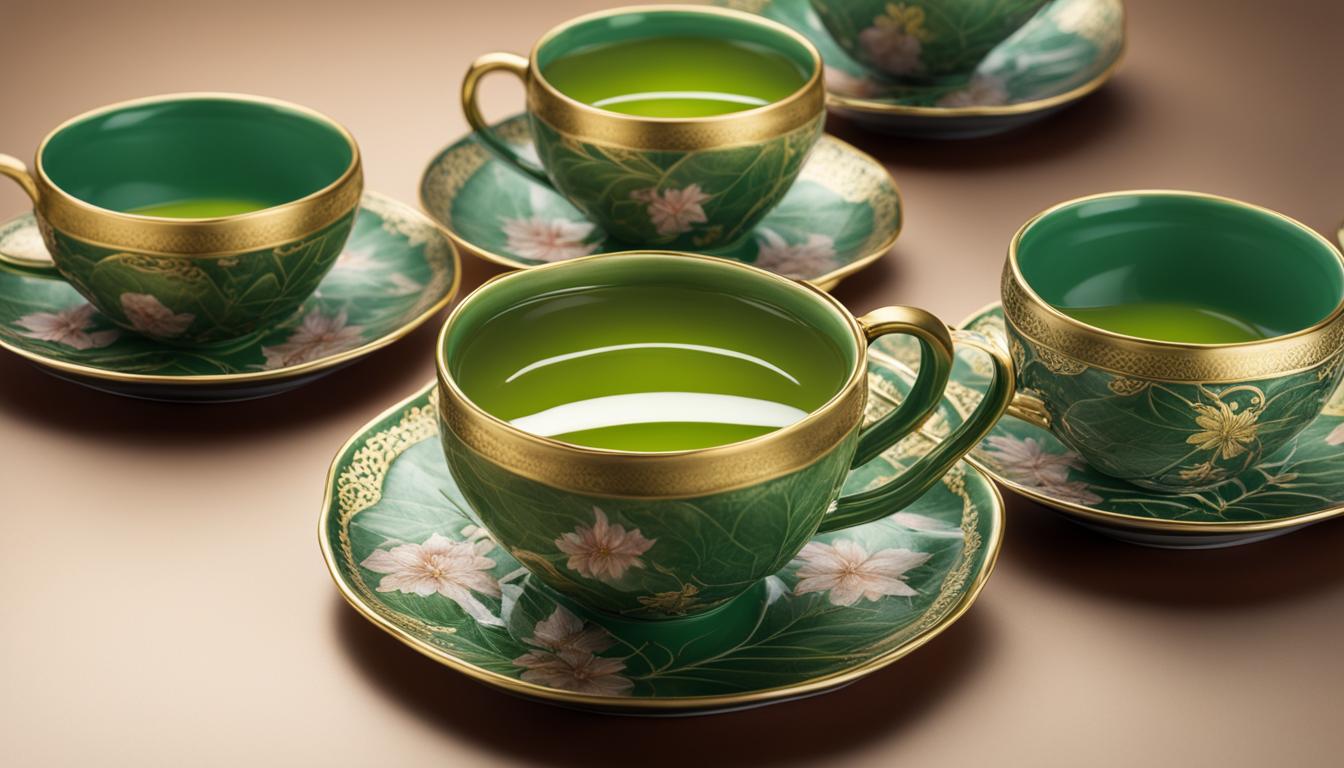Tea blending is an exquisite art that requires dedication and finesse. At its core, blending tea is about creating harmonious flavors by combining different types of tea from various origins. While there are no hard and fast rules when it comes to tea blending, the key is to strike a balance between the flavors and embrace your creativity. Whether you prefer green, black, or white tea, the possibilities are endless when it comes to crafting unique and delightful tea blends. So, let’s embark on a journey to master the art of tea blending and elevate our tea experience to new heights!
Key Takeaways:
- Tea blending is an art that requires experimentation and persistence.
- Start with one or two ingredients and gradually explore different combinations to find the perfect balance of flavors.
- Use ingredients of the same size and density to prevent de-blending.
- Choose flavors that complement the inherent flavor of the tea.
- Experiment with different tea varieties and flavors to create your own personalized tea blends.
Essential Tips for DIY Tea Blending
When it comes to DIY herbal tea blending, the possibilities are endless. By creating your own loose leaf tea blends, you have the opportunity to personalize your tea flavors and create unique combinations that suit your taste preferences. Whether you’re a tea enthusiast or a beginner, here are some essential tips to help you master the art of tea blending:
- Be fearless and experimental: Tea blending is all about exploring different flavors and combinations. Don’t be afraid to mix and match ingredients to create unexpected and delightful blends. Embrace your creativity and let your taste buds be your guide.
- Start with one or two ingredients: If you’re new to tea blending, it’s best to start with a simple recipe using one or two ingredients. This will allow you to understand how the flavors interact and find the perfect balance that suits your palate.
- Balance the flavors: Tea should remain the main ingredient in your blend, while flavors should enhance the overall taste. As a general rule, aim for two-thirds tea and one-third flavors in your blend. This will ensure that the inherent flavor of the tea shines through while adding a hint of something extra.
- Crush spices and chop dried fruits: To release the full flavor of spices, it’s best to crush them before adding them to your blend. For dried fruits, make sure to chop them into equal-sized pieces. This will ensure that the flavors are evenly distributed throughout your tea.
Remember, the key to successful DIY herbal tea blending is to experiment, have fun, and let your taste buds guide you. Don’t be afraid to try new combinations and explore different flavors. Happy blending!
Table: Common Ingredients for DIY Tea Blends
| Ingredient | Description |
|---|---|
| Cocoa | Adds a rich, chocolatey flavor to teas. |
| Cardamom | Provides a warm and aromatic taste to blends. |
| Cinnamon | Brings a sweet and spicy flavor to teas. |
| Vanilla Bean | Imparts a creamy and sweet aroma to blends. |
| Anise | Offers a subtle licorice-like taste to teas. |
| Orange Peel | Brings a tangy and citrusy flavor to blends. |
| Dried Berries | Adds a burst of fruity sweetness to teas. |
| Cloves | Provides a warm and spicy note to blends. |
| Ginger | Imparts a zesty and invigorating taste to teas. |
| Dried Fruits (e.g., pineapple) | Offers a tropical and sweet flavor to blends. |
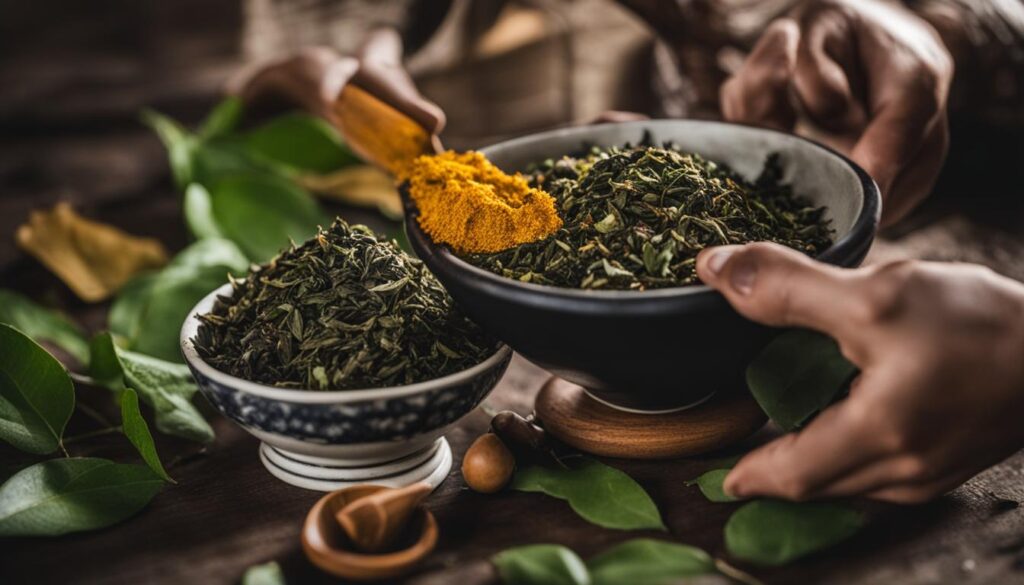
The Art of Blending Tea: Exploring Flavor Combinations
Tea blending is a delightful journey of discovering unique and flavorful combinations. With endless possibilities, you can create homemade tea blends that suit your taste preferences. By exploring different flavor combinations, you can craft teas that are truly one-of-a-kind. Let’s delve into some delicious homemade tea blend recipes that will elevate your tea drinking experience.
Green Tea Blends:
Green tea, with its earthy and refreshing taste, pairs beautifully with a variety of flavors. Consider blending green tea with ingredients like toasted walnuts, coconut flakes, popcorn, or a hint of refreshing mint. These combinations add depth and complexity to the tea, creating a harmonious balance of flavors that tantalize the taste buds.
Black Tea Blends:
Black tea, known for its bold and flavorful character, can be enhanced with the addition of dry flavors. Try blending black tea with cardamom or cinnamon for a rich and aromatic cup of tea. The warmth and spice from these ingredients perfectly complement the robust nature of black tea, resulting in a truly satisfying blend.
White Tea Blends:
If you prefer a delicate and sweet taste, white tea is the perfect base for your blend. Create a light and floral blend by adding lavender, orange peel, or rose petals to white tea. These gentle flavors enhance the natural sweetness of white tea, creating a fragrant and soothing cup of tea.
| Tea Variety | Recommended Flavors |
|---|---|
| Green Tea | Toasted walnuts, coconut flakes, popcorn, mint |
| Black Tea | Cardamom, cinnamon |
| White Tea | Lavender, orange peel, rose petals |
These are just a few examples of the many flavor combinations you can experiment with when blending your own teas. Feel free to customize and create tea blends that reflect your unique taste preferences. So why not embark on a tea blend creation adventure today and let your creativity soar?
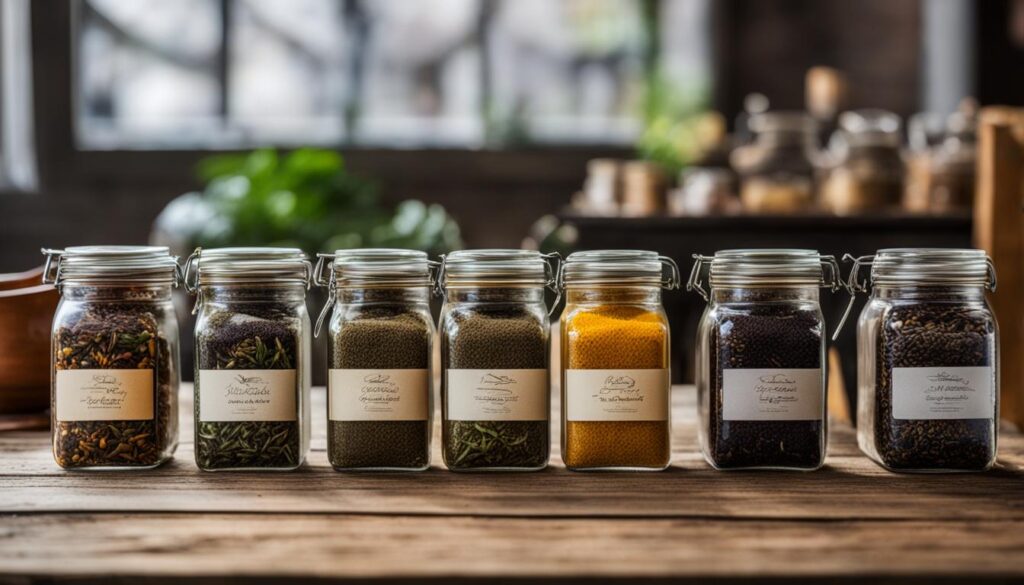
Growing Tea Plants for DIY Blending
Are you ready to take your tea blending skills to the next level? Why not consider growing your own tea plants? Not only does growing your own tea give you the opportunity to create custom blends, but it also allows you to experiment with different flavors and explore the unique terroir of your local environment.
When it comes to growing tea plants, it’s important to choose the right variety for your specific climate and conditions. The Camellia sinensis plant is the traditional source of true teas, but you can also grow a variety of herbs, spices, flowers, and leaves to create herbal infusions or customize your own tea blends. By observing the blooming patterns of plants in your environment, you can harvest them at different times to capture the fullest flavors. And don’t forget, proper drying techniques are essential to maintain the potency of your plants.
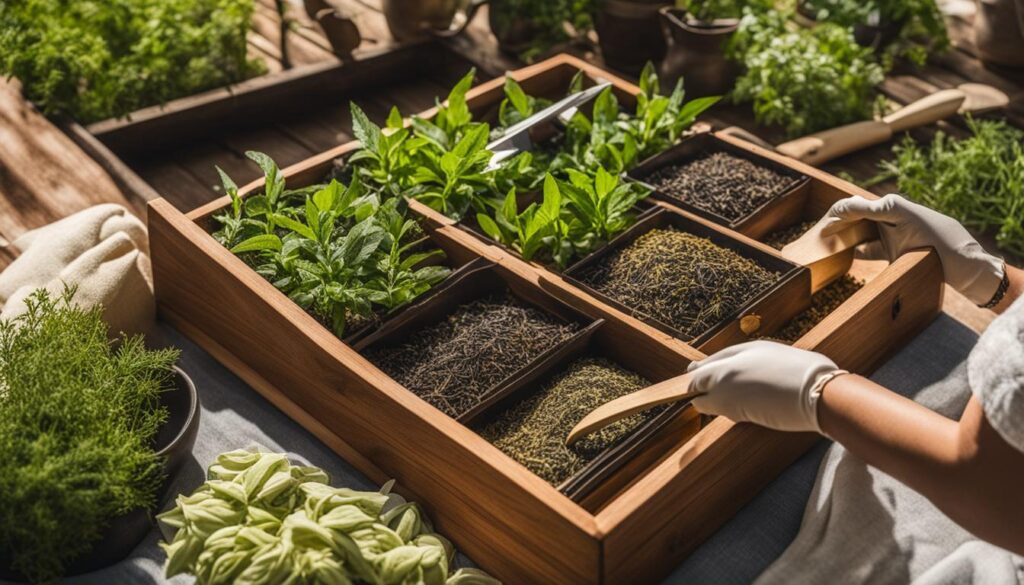
Once you’ve harvested and dried your tea ingredients, it’s time to start blending. Experiment with different flavor combinations and ratios to create your own unique tea blends. Mix and match different tea leaves, herbs, spices, and fruits to find the perfect balance of flavors. Whether you prefer a bold and robust blend or a delicate and floral infusion, the possibilities are endless!
In summary, growing your own tea plants allows you to customize your blends and create teas that truly reflect your local environment. With a bit of patience and experimentation, you can master the art of DIY tea blending and unlock a world of delicious and personalized tea flavors.
Conclusion
Tea blending is not just an art, but a delightful journey of discovering new flavors and creating unique blends tailored to your taste. With our beginner’s guide to tea blending and the right tips, you’ll become a master blender in no time.
Experimentation is the key to mastering the art of tea blending. Start with one or two ingredients, gradually adding more to create complex and interesting blends that excite your taste buds. But always remember, tea should remain the star of the blend, with the flavors enhancing its natural essence.
Don’t limit yourself to just pre-packaged teas; growing your own tea plants opens up a whole new world of flavors. By observing the blooming patterns of plants in your environment and harvesting at the right times, you can create teas that truly reflect your local terroir.
So, whether you’re a tea blending beginner or a seasoned enthusiast, let your passion for tea guide you on this flavor-filled adventure. With our tea blend creation tips, you’ll be well-equipped to brew your own personalized cup of happiness. Get blending and savor every sip!
FAQ
What is tea blending?
Tea blending is the art of combining different varieties of tea leaves with other ingredients to create unique flavor profiles.
How do you balance flavors when blending tea?
Balancing flavors in tea blending comes with experience. Start with one or two ingredients and gradually experiment to find the perfect balance.
Can I use fresh ingredients for tea blending?
Yes, fresh ingredients can be used depending on the type of tea. However, dry ingredients with concentrated flavors are preferred for blending.
What proportions of tea and flavors should be used in a blend?
The proportions of tea and flavors in a blend should be balanced, with two-thirds of the blend consisting of tea and the rest made up of flavors.
Which flavors go well with different types of tea?
Green tea pairs well with toasty flavors like popcorn, walnuts, coconut, and mint. Black tea goes well with dry flavors like cardamom and cinnamon. White tea pairs well with light flavors like lavender, orange peel, and rose petals.
What are some popular ingredients for tea blending?
Popular ingredients for tea blending include cocoa, cardamom, cinnamon, vanilla bean, anise, orange peel, dried berries, cloves, ginger, and dried fruits like pineapple.
Can I grow my own tea plants for blending?
Yes, growing your own tea plants gives you the opportunity to create custom blends and experiment with different flavors.
How do I store my blended teas?
Dried materials should be stored in airtight containers away from light and heat to maintain their potency.
How do I start blending my own teas?
Start by mastering the basics and gradually experiment with different flavors to create unique and personalized blends.
Is tea blending a rewarding experience?
Absolutely! Tea blending allows you to unleash your creativity and create teas that suit your taste preferences.
Source Links
- https://teafloor.com/blog/the-art-of-tea-blending/
- https://www.sunset.com/home-garden/flowers-plants/diy-tea-blend-ideas
- https://upload.wikimedia.org/wikipedia/commons/9/9e/The_art_of_tea_blending_-_A_handbook_for_the_tea_trade-_a_guide_to_tea_merchants,_brokers,_dealers,_and_consumers,_in_the_secret_of_successful_tea_mixing_(IA_b28056024).pdf

